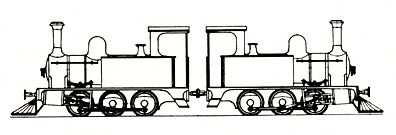CGR 0-6-0T 1876 Back-to-Back
| CGR 0-6-0T 1876 Back-to-Back | |
|---|---|
|
Drawing of CGR 0-6-0T Back-to-Back locomotive pair | |
| Type and origin | |
| Power type | Steam |
| Designer | Robert Stephenson and Company |
| Builder | Robert Stephenson and Company |
| Serial number | 2257-2258, 2354 [1][2][3] |
| Model | Stephenson’s Patent Back-to-back |
| Build date | 1875, 1879 |
| Specifications | |
| Configuration | 0-6-0T |
| Gauge | 3 ft 6 in (1,067 mm) Cape gauge |
| Driver diameter | 37 1⁄2 in (952 mm) |
| Wheelbase |
8 ft (2.438 m) single loco 29 ft (8.839 m) loco pair [4] |
| Length | 21 ft 4 in (6.502 m) over couplers |
| Height | 12 ft (3.658 m) |
| Locomotive weight | 18 long tons (18.3 t) per unit w/o |
| Fuel type | Coal |
| Boiler | 6 ft (1.829 m) pitch |
| Boiler pressure | 125 psi (862 kPa) |
| Firegrate area | 10 sq ft (0.929 m2) |
| Heating surface: – Tubes | 850 sq ft (78.968 m2) |
| – Firebox | 92 sq ft (8.547 m2) |
| – Total | 942 sq ft (87.515 m2) |
| Cylinders | Two |
| Cylinder size |
12 in (305 mm) bore 20 in (508 mm) stroke |
| Valve gear | Stephenson [4] |
| Performance figures | |
| Tractive effort | 7,600 lbf (34 kN) per unit at 75% pressure |
| Career | |
| Operator(s) | Cape Government Railways |
| Number in class | 3 |
| Number(s) | E5-E7 [1] |
| Delivered | 1876, 1879 |
| First run | 1876 |
| Last run | 1912 [4][5] |
The CGR 0-6-0T Back-to-Back of 1876 is a South African steam locomotive from the pre-Union era in the Cape Colony.
In 1876 the Cape Government Railways placed a pair of 0-6-0 Stephenson’s Patent permanently coupled back-to-back side-tank locomotives in service on its Eastern System. They worked out of East London in comparative trials with the experimental 0-6-6-0 Fairlie locomotive that was acquired in that same year.[4][5]
A third single locomotive of the same design was delivered to the Eastern System in 1879.[1][3]
Manufacturer
To address the need for more powerful locomotives on the Eastern System of the Cape Government Railways due to the heavy grades on the line that was being built out of East London, a pair of Stephenson’s patent permanently coupled back-to-back 0-6-0 side-tank locomotives was ordered from Robert Stephenson and Company for experimental purposes in 1875. The locomotives were shipped on the vessel Claremont and arrived in East London on 1 February 1876, numbered E5 and E6 in the Eastern System's number range. A third single locomotive of the same class, numbered E7 and also built by Robert Stephenson, was delivered in 1879.[1][2][4][5]
Locomotive trials
Characteristics
The principle of using two tank locomotives that are permanently coupled at their cab ends was patented by Robert Stephenson and Company in 1855. The arrangement allowed the two locomotives to be operated by a single crew. A similar arrangement was later used with the German-built Zwillinge locomotives that saw service on the military-built narrow gauge Feldbahn railway lines in South West Africa and other German territories, where pairs of individual locomotives lettered A and B were semi-permanently coupled back-to-back.[4][5][6]
Shortcomings
The Stephenson’s Patent locomotives were evaluated during comparative trials with the experimental 0-6-6-0 Fairlie locomotive that was acquired at the same time. Like the Fairlie, the twin engines performed well on curves. Unlike the Fairlie, however, any imperfections in the track affected them badly, especially while descending down a decline. The trailing engine tended to jerk the leading engine from side to side so severely that power had to be applied to the leading engine while braking the trailing engine in order to stabilise it.[4][5]
Better results were obtained by separating the pair and running them in the conventional double-heading manner with both locomotives facing in the same direction. The downside of this option, however, was that it required two crews.[5]
Service
It was eventually decided to separate the locomotives permanently, equip them with tenders and use them as shunting engines. In this configuration and application they performed well enough to remain in service until they were scrapped in 1912.[4][5]
No photograph has yet been found of any of these locomotives.
See also
- The 0-6-0 wheel arrangement
- CGR Fairlie 0-6-6-0
- South African locomotive history
- List of South African locomotive classes
References
- ↑ 1.0 1.1 1.2 1.3 C.G.R. Numbering Revised, Article by Dave Littley, SA Rail May–June 1993, pp. 94-95.
- ↑ 2.0 2.1 What were these, 2-6-0T or 0-6-0T?
- ↑ 3.0 3.1 Holland, D.F. (1972). Steam Locomotives of the South African Railways, Volume 2: 1910-1955 (1st ed.). Newton Abbott, Devon: David & Charles. p. 120. ISBN 978-0-7153-5427-8.
- ↑ 4.0 4.1 4.2 4.3 4.4 4.5 4.6 4.7 Holland, D.F. (1971). Steam Locomotives of the South African Railways, Volume 1: 1859-1910 (1st ed.). Newton Abbott, Devon: David & Charles. pp. 25–28. ISBN 978-0-7153-5382-0.
- ↑ 5.0 5.1 5.2 5.3 5.4 5.5 5.6 Dulez, Jean A. (2012). Railways of Southern Africa 150 Years (Commemorating One Hundred and Fifty Years of Railways on the Sub-Continent - Complete Motive Power Classifications and Famous Trains - 1860-2011) (1st ed.). Garden View, Johannesburg, South Africa: Vidrail Productions. pp. 21–22. ISBN 9 780620 512282.
- ↑ Paxton, Leith; Bourne, David (1985). Locomotives of the South African Railways (1st ed.). Cape Town: Struik. pp. 117, 121. ISBN 0869772112.
